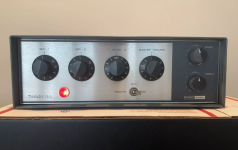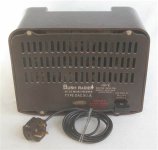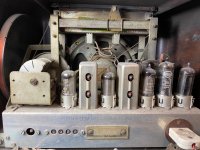One would think isolation transformers would be more popular! 1:1, separate windings on isolating bobbin.People used to listen to hot chassis radios while taking a bath.
I still recall the day when I was pissed off, having discovered the Variac was not an isolating transformer. Why couldnt they have wound a primary just underneath those secondary turns? It'd work just fine - Bast----!
🤦♂️Many would have plugged their Bush into one of these back in the 1950s:
View attachment 1401857
When they weren't doing their ironing of course!
View attachment 1401858
Hot chassis radios were usually well-insulated from the user, although the paper capacitors used for the aerial connectors are usually leaky by now.
People used to listen to hot chassis radios while taking a bath.
Bathrooms could be cold places back in the 1950s:
I once found a Waldorp radio (company from The Hague that put Philips chassis in prettier enclosures) from the late 1930's. It had a supply transformer, no hot chassis, but it also had a connection for an external high-impedance loudspeaker taken from the primary of its output transformer.
That is, on one side of its back there were sockets for banana plugs for the aerial, one of which was connected straight to signal ground, on the other side there were sockets for banana plugs for the external loudspeaker, one of which was connected straight to the 300 V or so supply. The sockets were made such that when you touched them, you made contact to their metal.
The back side of the radio was missing, so I just made an improvised back side that covered the external loudspeaker sockets.
That is, on one side of its back there were sockets for banana plugs for the aerial, one of which was connected straight to signal ground, on the other side there were sockets for banana plugs for the external loudspeaker, one of which was connected straight to the 300 V or so supply. The sockets were made such that when you touched them, you made contact to their metal.
The back side of the radio was missing, so I just made an improvised back side that covered the external loudspeaker sockets.
About twenty years ago my partner and I bought a 1950's French valve radio from the brand Sonorton, which had to be repaired. It had a supply transformer and valves meant for 6.3 V parallel heater supply, so I assumed that the chassis wasn't hot. Wrong assumption: it was a 6.3 V transformer with a centre tap on the primary that was used for the anode supply, like an autotransformer. By sheer luck, I didn't get any shock before finding that out.
Later, a friendly Frenchman with the same radio model informed me that the radio was actually supposed to have a normal transformer, with insulation from the mains for both the heater and the anode supply. Apparently someone had repaired it in a quite irresponsible manner. I found a suitable normal transformer that sort of fits at Radio Twenthe, a parts shop in The Hague, and now use it frequently.
Later, a friendly Frenchman with the same radio model informed me that the radio was actually supposed to have a normal transformer, with insulation from the mains for both the heater and the anode supply. Apparently someone had repaired it in a quite irresponsible manner. I found a suitable normal transformer that sort of fits at Radio Twenthe, a parts shop in The Hague, and now use it frequently.
A while back I bought a HK Troubador integrated amp based on looks alone, fully planning to retrofit it with something new and using the chassis and knobs for aesthetic. I haven't started that project, but am taking this thread as messaging from the universe to proceed with it.
[pic not of my item]
[pic not of my item]
Attachments
My mother would not allow me to take my 9V battery powered AM radio (remember those small radios about the size if a pack of cigarettes?) into the bathroom when I was a kid. I never could get it into her head that 9V was not the same as 220 VAC.
I have an old GE fan with the large spaces in the fan blade guard where you could slice fingers but this is nothing serious compared to the wiring.
It has 3 speeds with a metal lever to change speeds. The lever is HOT and has a useless short rubber insulating boot. My wife changed speeds but touched below the boot and got zapped.
I took it apart and then discovered the issue with the design. I just fixed it to one speed and removed the lever. it sits behind a wood stove to move heat.
We're a little crazy with being attracted to certain antiques🙁
It has 3 speeds with a metal lever to change speeds. The lever is HOT and has a useless short rubber insulating boot. My wife changed speeds but touched below the boot and got zapped.
I took it apart and then discovered the issue with the design. I just fixed it to one speed and removed the lever. it sits behind a wood stove to move heat.
We're a little crazy with being attracted to certain antiques🙁
...and still were this morning, despite large hot towel rail/frame and underfloor heating - soles of the feet were OK though!Bathrooms could be cold places back in the 1950s:

That heater looks as though it could warm the bather up - for good.

I lived in a large house in rural Ireland (the type known in Scotland as an 'Act of Union' house. The walls were 3 feet thick solid
stone with a plaster pebble dash finish. The bathroom had the luxury of an open fireplace. In the days of domestic servants
I imagine it was kept alight all winter.

Downstairs was as warm as toast with two open fires and shutters closed at dusk. If you let a fire out for 24hours a week
the temperature hardly dropped once the walls were warm. The kitchen had an Aga (solid fuel) so the ground floor was
snug...but to venture upstairs - which was as cold as charity - was a very brave act..

HNY All,
Back in the day, automobile manuals used to explain how to adjust the valve clearances.I suspect that common sense was a more widespread human trait back in the 1950s than it is today!
Now they tell you not to drink the battery acid.
John
The original Bush DAC90A did have a built in 'safety device'.
The mains plug was designed so that you had to remove it before you could remove the rear panel.

Bush DAC90A mains plug
Of course, many of these original mains connectors are now missing, as in Bonsai's example.
The mains plug was designed so that you had to remove it before you could remove the rear panel.
Bush DAC90A mains plug
Of course, many of these original mains connectors are now missing, as in Bonsai's example.
Attachments
The original mains connectors crop up at auction from time to time.

An arrow on top of the connector indicates the correct way round to insert the plug to ensure that the radio's chassis will be connected to the neutral pin of a UK 3-pin mains plug.
Take note Bonsai, if you decide to undertake a renovation.
An arrow on top of the connector indicates the correct way round to insert the plug to ensure that the radio's chassis will be connected to the neutral pin of a UK 3-pin mains plug.
Take note Bonsai, if you decide to undertake a renovation.
Actually, researching further, it appears that 'arrow' symbol is actually a 'pull' symbol which appears on both sides of the connector (see bottom plug image):

Bang goes my brilliant idea of that symbol being a 'safety feature'!
At least my illustration in post #35 indicates that it is possible to arrange the mains cable and original plug so as to ensure the chassis will not be live.
Bang goes my brilliant idea of that symbol being a 'safety feature'!
Thanks Galu!
At least my illustration in post #35 indicates that it is possible to arrange the mains cable and original plug so as to ensure the chassis will not be live.
On second thoughts, where would I fit a 1-1 isolation transformer. This was cutting edge consumer electronics - thrvthingbis compact!
- Home
- Member Areas
- The Lounge
- Safety


